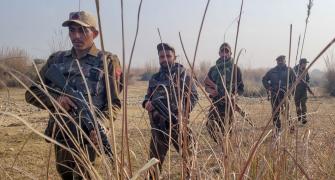Preliminary investigations into the deadly Ludhiana blasts show that the act of terror could have been carried out by Pakistan-based terrorists with the help of the Sikh militants.
The Intelligence Bureau says that the role of the two cannot be ruled out as both the outfits had been associated with each other for quite some time.
The IB had two years back sounded a warning regarding the revival of Sikh militancy in Punjab. A report by the IB shows that the Lashkar-e-Tayiba along with five other outfits were chosen by the ISI and entrusted with the job of training men from Babbar Khalsa International and International Sikh Youth Federation.
The training was imparted in use of weapons and also infiltration into India through the Jammu and Kashmir valley.
The IB report also says that the ISI had taken upon itself to revive Sikh militancy in a big way as the former felt that it needed a partner within India to carry out terror attacks. The first signs of the revival of Sikh militancy came to light in 2001, when they underwent a month long training programme in Pakistan.
Both the LeT and the BKI have set up a common office outside Nankana Sahib, a small town in sub divisional head quarter of Shekhupura in west Punjab in Pakistan. The report says that the ISI was ready to go to any extent to train the Sikh militants that all amenities were provided. The ISI had provided the militants outfits with bungalows and plenty of space to undertake training activity, the report also states.
The ISI was, however, very particular in keeping the link between the Sikh and Pakistan militants a low key affair. IB officials say that at no point of time, did the ISI want the world to know about this nexus. The reason being, the involvement of the Sikh militants was very important to infiltrate into India. Even after the 9/11 attacks the BKI and ISYF militants were shifted into Islamabad.
Apart from the LeT, the Pakistan-based Jamaat-e-Islami too is playing a key role in the revival of Sikh militancy. The JEI had held a meeting with the BKI recently at its headquarters in Mansoora. The JEI is learnt to have assured the BKI of all support. The BKI was even offered arms and training.
The report also relies on the speeches made by some of the Pakistan militants in which they discuss at length the historical links between the Sikhs and the Muslims. The ISI aims at creating a common ground between the two and wants to portray both the Sikhs and the Kashmiris as natural allies fighting against the government of India.
The ISI had also gone a step ahead and formed the Pakistan Sikh Gurdwara Prabhandhak Committee. This was seen as a subtle move by the ISI to achieve a long term goal.
The report says that ever since the formation of the PSGPC, the interaction between the pro-Khalistani Sikhs and Pakistan has substantially increased and the Pakistan government had also liberalized visas for such persons. The Pakistan outfits through this programme try and extract information regarding the security of India and also aim at spreading hatred, malice and discontentment within the communities in India.
Most wanted Sikh militants living in Pakistan:
- Wadhawan Singh Babbar: Chief of BKI, who is believed to be staying in Lahore.
- Ranjith Singh Neeta: Chief of Khalistan Zindabad Force, who is believed to be staying in Lahore.
- Paramjeet Singh Panjawar: Chief of Khalistan Commando force, who is believed to be staying in Lahore.
- Lakhbhir Singh Rode: Chief of ISYF, who is believed to be staying in Lahore.
- Gajinder Singh: The leader of Dal Khalsa is believed to be staying in Lahore after being released from jail.







